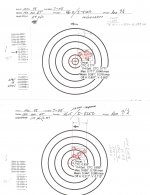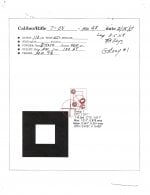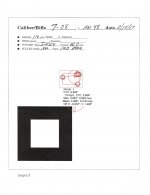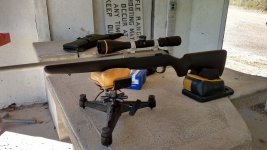walkinhorseman
Beginner
- Sep 28, 2010
- 182
- 182
To close on my review, I would like to report the accuracy and final evaluation of the Nosler 48 Heritage 7-08.
Attached are four targets which are representative of the precision that I was able to achieve with this rifle. Note that the test distance was 110 or 114 yards. These are all five shot groups. I require my hunting rifles to produce less than a MOA for 5 consecutive shots. Three shot groups ARE NOT statistically representative of a rifles true precision. Neither is a single group during one range session. Those shooters that live by the three shot group may very likely be making decisions on precision and accuracy which are not credible. Three shot groups have some utility on initial OCW and seating depth tests but those initial test findings should be verified with multiple 5 shot groups to gain statistical confidence in the load. If you are convinced that 3-shot groups are more applicable to a sporting rifle, then a sampling of 10 separate groups should be taken and averaged. Brian Litz has some writings on “Dispersion” in Modern Advancements Volume II that supports my opinion. I rather imagine that my three group statement will not be well received. It is not intended to set off a firestorm of retorts as much as to suggest to shooters to better evaluate their data.
http://bisonballistics.com/articles/opt ... for-rifles
This load chronographed at 2800 fps. My initial development was with the 140 grain Ballistic Tip and I simply substituted the AccuBond to verify its’ precision. Frankly, these two bullets will probably be adequate for my purposes for this rifle. I may work with the Barnes TSX 140 grain. But for now, this rifle is good to go. I’ll take a 140 at 2800 with reliable MOA precision any day.
The performance of this rifle meets my expectations. General workmanship is excellent. I have two remaining criticisms at this point. The first is the rough chamber shoulder. It appears that the reamer in the shoulder section was not sharp or chips accumulated in this area to cut a shoulder that produces rings on the fired cases. I did check the headspace and it is in spec. This defect is not a functional issue and since this is a hunting rifle, I’ll live with it.
The trigger system still remains a disappointment for me. When received, it broke at 3.5# and had a lot of creep, exhibiting a long rough travel before breaking. This rifle has the Rifle Basics trigger with a 2-position safety, which does not lock the bolt. I was able to adjust it down to 2.5# and reduce the amount of travel, however, it remains rough with a lot of creep.
Any rifle that is carried in the field needs to have a bolt lock safety. I can deal with a two-position safety but it must lock the bolt. I guess if you hunt from a stand or carry with an empty chamber, it doesn’t matter. But for my style of hunting, it becomes a reliability issue with the bolt becoming inadvertently opened while carrying in a sling.
I did call Nosler Customer Service. They were willing to install the Timney with the 3-position safety for $200. That is basically the cost of trigger and return shipping. With my shipping costs, the conversion would be ~$260 for a trigger that sells for $130. Timney would not sell me the trigger as they have a proprietary agreement with Nosler and won’t sell it to the consumer. Damn the lawyers. I recently purchased a Tikka T3 Lite for $549 that has a two position BOLT LOCK SAFETY and a much crisper factory trigger. The 3-position Timney should be the standard trigger for the Nosler 48. The action body and bolt are machined for the locking blade. I don’t see this as a cost issue, but rather as a holdback by Nosler for their Custom Models.
I still hold the Sako L-Series and A-Series as my gold standard for a hunting rifle. The flat bottomed action with integral recoil lug, integral dovetail scope bases, excellent adjustable triggers, bolt lock safety, and reliably excellent barrels were their hallmark. The only two areas that Nosler needs to improve the Model 48 are the trigger/safety systems and integral mount bases, most likely the Weaver style to be current with modern trends. One leg up on the old Sakos for the 48 is the modern Cerakote finish vs standard bluing.
By and large, I am very satisfied with the Nosler 48 Heritage. It is a very pleasing rifle. The Nosler 48 is not perfect, however it very well may be the best dollar value out there in a consumer level classic hunting rifle. It has many of the best functional and esthetic design features that are desirable in a good hunting rifle.
Attached are four targets which are representative of the precision that I was able to achieve with this rifle. Note that the test distance was 110 or 114 yards. These are all five shot groups. I require my hunting rifles to produce less than a MOA for 5 consecutive shots. Three shot groups ARE NOT statistically representative of a rifles true precision. Neither is a single group during one range session. Those shooters that live by the three shot group may very likely be making decisions on precision and accuracy which are not credible. Three shot groups have some utility on initial OCW and seating depth tests but those initial test findings should be verified with multiple 5 shot groups to gain statistical confidence in the load. If you are convinced that 3-shot groups are more applicable to a sporting rifle, then a sampling of 10 separate groups should be taken and averaged. Brian Litz has some writings on “Dispersion” in Modern Advancements Volume II that supports my opinion. I rather imagine that my three group statement will not be well received. It is not intended to set off a firestorm of retorts as much as to suggest to shooters to better evaluate their data.
http://bisonballistics.com/articles/opt ... for-rifles
This load chronographed at 2800 fps. My initial development was with the 140 grain Ballistic Tip and I simply substituted the AccuBond to verify its’ precision. Frankly, these two bullets will probably be adequate for my purposes for this rifle. I may work with the Barnes TSX 140 grain. But for now, this rifle is good to go. I’ll take a 140 at 2800 with reliable MOA precision any day.
The performance of this rifle meets my expectations. General workmanship is excellent. I have two remaining criticisms at this point. The first is the rough chamber shoulder. It appears that the reamer in the shoulder section was not sharp or chips accumulated in this area to cut a shoulder that produces rings on the fired cases. I did check the headspace and it is in spec. This defect is not a functional issue and since this is a hunting rifle, I’ll live with it.
The trigger system still remains a disappointment for me. When received, it broke at 3.5# and had a lot of creep, exhibiting a long rough travel before breaking. This rifle has the Rifle Basics trigger with a 2-position safety, which does not lock the bolt. I was able to adjust it down to 2.5# and reduce the amount of travel, however, it remains rough with a lot of creep.
Any rifle that is carried in the field needs to have a bolt lock safety. I can deal with a two-position safety but it must lock the bolt. I guess if you hunt from a stand or carry with an empty chamber, it doesn’t matter. But for my style of hunting, it becomes a reliability issue with the bolt becoming inadvertently opened while carrying in a sling.
I did call Nosler Customer Service. They were willing to install the Timney with the 3-position safety for $200. That is basically the cost of trigger and return shipping. With my shipping costs, the conversion would be ~$260 for a trigger that sells for $130. Timney would not sell me the trigger as they have a proprietary agreement with Nosler and won’t sell it to the consumer. Damn the lawyers. I recently purchased a Tikka T3 Lite for $549 that has a two position BOLT LOCK SAFETY and a much crisper factory trigger. The 3-position Timney should be the standard trigger for the Nosler 48. The action body and bolt are machined for the locking blade. I don’t see this as a cost issue, but rather as a holdback by Nosler for their Custom Models.
I still hold the Sako L-Series and A-Series as my gold standard for a hunting rifle. The flat bottomed action with integral recoil lug, integral dovetail scope bases, excellent adjustable triggers, bolt lock safety, and reliably excellent barrels were their hallmark. The only two areas that Nosler needs to improve the Model 48 are the trigger/safety systems and integral mount bases, most likely the Weaver style to be current with modern trends. One leg up on the old Sakos for the 48 is the modern Cerakote finish vs standard bluing.
By and large, I am very satisfied with the Nosler 48 Heritage. It is a very pleasing rifle. The Nosler 48 is not perfect, however it very well may be the best dollar value out there in a consumer level classic hunting rifle. It has many of the best functional and esthetic design features that are desirable in a good hunting rifle.








